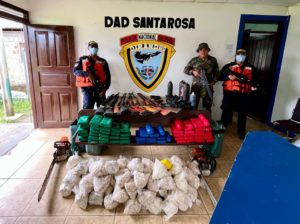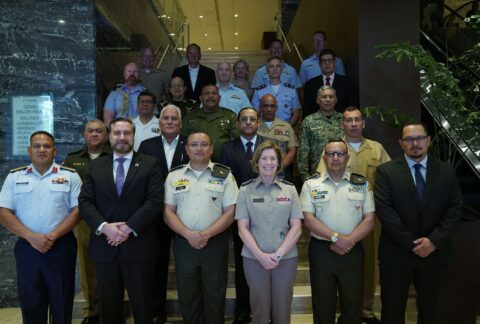Colombia and Peru have been stepping up the fight against narcotrafficking along their common border, dealing a hard blow to criminal groups involved in this illicit activity. As such, among their various efforts, over the course of three weeks, the Colombian Military Forces, in combined operations with the Peruvian National Police’s Anti-Drug Directorate (Dirandro), located and destroyed 18 illegal coca base paste processing laboratories, a cocaine hydrochloride crystallization lab, and three illegal storage facilities, the Colombian Navy reported in a statement.

The operations carried out in the Colombian departments of Caquetá, Meta, Guaviare, and Putumayo, as well as in the Peruvian department of Loreto, also resulted in the capture of 14 people: members of dissident groups of the Revolutionary Armed Forces of Colombia (FARC), as well as Peruvian and Brazilian criminals, the Navy said.
In mid-June, Colombian Army Vice Admiral Harry Ernesto Reyna Niño, commander of the Southern Naval Force, provided Diálogo with details of the operations and highlighted Dirandro’s positive support and said that it was due in part “to the good relations and operational coordination that they have with the naval units of the Colombian Navy.”
The operations
Authorities found the coca base paste processing labs in Colombian territory, under the leadership of the Colombian Army’s Marine Infantry Brigade No. 3. In the facilities, authorities found 9,808 kilograms of chopped leaves, 818 liters of processing coca base paste, more than 19,000 liters of liquid chemical precursors, 1,216 kg of solid chemical precursors, and 29 kg of coca base; in addition to machinery and equipment, the Colombian Navy said. Troops also found three illegal warehouses storing almost 29,000 liters of liquid chemical precursors and 29 kg of solid chemical precursors to process the drugs.
Meanwhile, units of the Colombian Navy’s Riverine Marine Infantry Battalion No. 32 found a cocaine hydrochloride crystallization lab in the municipality of La Macarena, Meta department. In the facility, which had the capacity to produce several kilograms of coca base paste per month, authorities captured eight members of FARC dissident groups, who were found carrying out activities related to drug production.
Four Peruvians and two Brazilians were also captured in Peruvian territory, said Vice Adm. Reyna. The criminals had more than 140 packages of cocaine hydrochloride and coca base paste in their possession, several pistols, hunting shotguns, communication equipment, and cash.

Colombia and Peru are the two main cocaine producers worldwide. According to the U.S. State Department’s 2022 International Narcotics Control Strategy Report, cocaine production in Colombia is estimated to have increased from 918 tons in 2019 to 1,010 tons in 2020, while in Peru, production increased by 25 percent to 810 tons. Peru is also a major importer of chemical precursors for cocaine production, the report indicates.
Border cooperation
In the first half of January 2022, the governments of Colombia and Peru agreed to strengthen the fight against crime and intensify border cooperation to stop transnational crime, reported German news agency DW.
“The defense ministries have agreed to share intelligence, counterintelligence information, and also define common strategies to fight transnational crime,” said Colombian President Iván Duque following a meeting near Bogotá with Peruvian President Pedro Castillo.
The strategy focuses on narcotrafficking groups, but also illegal mining, wildlife smuggling, and seeks to dismantle chemical supply networks that contribute to environmental degradation in both territories.









